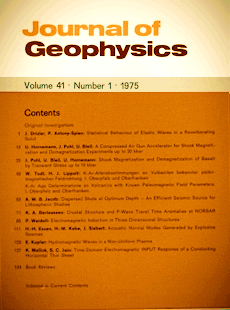Computations of SV waves in realistic Earth models
Article Sidebar

Vols. 1-18 (1924-1944), ISSN 0044-2801
Main Article Content
Abstract
The reflectivity method for the calculation of theoretical body-wave seismograms is extended to include a double-couple point source. Theoretical seismograms of SV waves from this type of source are presented for models of the Earth's crust and the crust-mantle boundary, and for models of the whole Earth. In the models of the crust-mantle boundary, there are up to four SV head waves, depending on the sharpness of the transition. The most remarkable one is slightly slower and later than Sn and has unusually low frequencies. Theoretical SV-wave seismograms for models of the whole Earth for periods from 15 s to 60 s and in the epicentral distance range from 10° to 160° show as prominent phases S, ScS, SKS and SKKS. SKS, and SKKS are different in wave form, in agreement with observations from long-period WWNSS stations. A diffracted wave SPdiffKS + SKPdiffS is found in the theoretical seismograms whose travel-time curve is tangential to that of SKS at a distance of 107 °. The resulting interference causes the wave form of SKS to change markedly around 120°. Since the theoretical seismograms are the complete response of the Earth models from the crust-mantle boundary down to the inner core, they also include many multiple and converted phases. Besides those associated with the crust-mantle boundary there are phases related to the transition zones in the upper mantle. Their amplitudes depend strongly on the sharpness of these zones.
 ARK: https://n2t.net/ark:/88439/y089618
ARK: https://n2t.net/ark:/88439/y089618
Permalink: https://geophysicsjournal.com/article/249
Article Details
References
Buchbinder, G.G.R. (1974) Diffraction from the PKP caustic B. Bull. Seism. Soc. Am. 64:33-43
Bullen, K.E. (1963) An introduction to the theory of seismology. Third ed. Cambridge University Press, London
Cerveny, V. (1974) Reflection and transmission coefficients for transition layers. Studia geoph. et geod. 18:59-68
Chapman, C.H. (1973) The Earth flattening transformation in body wave theory. Geoph. J. R. A. s. 35:55-70
Choy, G.L., Richards, P.G. (1975) Pulse distortion and Hilbert transformation in multiply reflected and refracted body waves. Bull. Seism. Soc. Am. 65 (In press)
Dunkin, J.W. (1965) Computation of modal solutions in layered media at high frequencies. Bull. Seism. Soc. Am. 55:335-358
Dziewonski, A.M., Gilbert, F. (1971) Solidity of the inner core of the Earth inferred from normal mode observations. Nature 234:465-466
Edel,J .-B., Fuchs, K., Gelbke, C., Prodehl, C. (1974) Deep structure of the southern Rhinegraben area from seismic refraction measurements. Submitted to J. Geophys.
Ewing, W.M., Jardetzky, W.S., Press, F. (1957) Elastic waves in layered media. McGraw-Hill Book Comp., New York
Fuchs, K. (1968a) Das Reflexions- und Transmissionsvermogen eines geschichteten Mediums mit beliebiger Tiefen-Verteilung der elastischen Moduln und der Dichte fi.ir schragen Einfall ebener Wellen. J. Geophys. 34:389-413
Fuchs, K. (1968b) The reflection of spherical waves from transition zones with arbitrary depthdependent elastic moduli and density. J. Phys. Earth 16:27-41 (Special Issue)
Fuchs, K., Muller, G. (1971) Computation of synthetic seismograms with the reflectivity method and comparison with observations. Geophys. ]. R. A. S. 23:417-433
Gilbert, F., Laster, S.J. (1962) Excitation and propagation of pulses on an interface. Bull. Seism. Soc. Am. 52:299-319
Haskell, N.A. (1953) The dispersion of surface waves in multi-layered media. Bull. Seism. Soc. Am. 43:17-34
Helmberger, D.V., Engen, G. (1974) Upper mantle shear structure, J. Geophys. Res. 79:4017-4028
Hill, D.P. (1972) An Earth-flattening transformation for waves from a point source. Bull. Seism. Soc. Am. 62:1195-1210
Hirn, A., Steinmetz, L., Kind, R., Fuchs, K. (1973) Long range profiles in Western Europe: II. Fine structure of the lower lithosphere in France (southern Bretagne). J. Geophys. 39:363-384
Johnson, L.R. (1969) Array measurements of P velocities in the lower mantle. Bull. Seism. Soc. Am. 59:973-1008
Kind, R. (1974) Long range propagation of seismic energy in the lower lithosphere. J. Geophys. 40:189-202
Mitchell, B.J., Helmberger, D.V. (1973) Shear velocities at the base of the mantle from observations of Sand ScS. J. Geophys. Res. 78:6009-6020
Muller, G. (1969) Theoretical seismograms for some types of point-sources in layered media. Part III: Single force and dipole sources of arbitrary orientation. J. Geophys. 35:347-371
Muller, G. (1971) Approximate treatment of body waves in media with spherical symmetry. Geophys. J. R. A. S. 23:435-449
Muller, G. (1973a) Amplitude studies of core phases. J. Geophys. Res. 78:3469-3490
Muller, G. (1973b) Theoretical body wave seismograms for media with spherical symmetry-discussion and comparison of approximate methods. J. Geophys. 39:229-246
Press, F. (1972) The Earth's interior as inferred from a familiy of models. In: Robertson, E.C. (Ed.) The nature of the solid Earth, 147-171. McGraw-Hill Book Comp., New York
Qamar, A. (1973) Revised velocities in the Earth's core. Bull. Seism. Soc. Am. 63:1073-1105
Roever, W.L., Vining, T.F., Strick, E. (1959) Propagation of elastic wave motion from an impulse source along a fluid-solid interface, I, II, III. Phil. Trans. Roy. Soc. London, Ser. A, 251:455-523
Wiggins, R.A., McMechan, G.A., Toksoz, M.N. (1973) Range of Earth structure nonuniqueness implied by body wave observations. Rev. Geophys. Space Phys. 11:87-113











